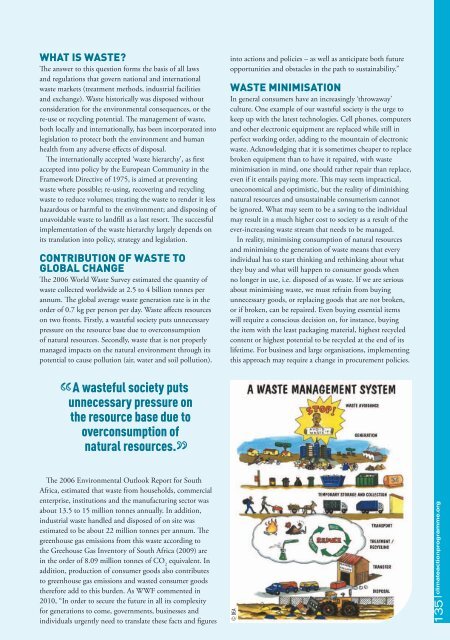Climate Action 2011-2012
You also want an ePaper? Increase the reach of your titles
YUMPU automatically turns print PDFs into web optimized ePapers that Google loves.
What is Waste?<br />
The answer to this question forms the basis of all laws<br />
and regulations that govern national and international<br />
waste markets (treatment methods, industrial facilities<br />
and exchange). Waste historically was disposed without<br />
consideration for the environmental consequences, or the<br />
re-use or recycling potential. The management of waste,<br />
both locally and internationally, has been incorporated into<br />
legislation to protect both the environment and human<br />
health from any adverse effects of disposal.<br />
The internationally accepted ‘waste hierarchy’, as first<br />
accepted into policy by the European Community in the<br />
Framework Directive of 1975, is aimed at preventing<br />
waste where possible; re-using, recovering and recycling<br />
waste to reduce volumes; treating the waste to render it less<br />
hazardous or harmful to the environment; and disposing of<br />
unavoidable waste to landfill as a last resort. The successful<br />
implementation of the waste hierarchy largely depends on<br />
its translation into policy, strategy and legislation.<br />
Contribution of Waste to<br />
global Change<br />
The 2006 World Waste Survey estimated the quantity of<br />
waste collected worldwide at 2.5 to 4 billion tonnes per<br />
annum. The global average waste generation rate is in the<br />
order of 0.7 kg per person per day. Waste affects resources<br />
on two fronts. Firstly, a wasteful society puts unnecessary<br />
pressure on the resource base due to overconsumption<br />
of natural resources. Secondly, waste that is not properly<br />
managed impacts on the natural environment through its<br />
potential to cause pollution (air, water and soil pollution).<br />
into actions and policies – as well as anticipate both future<br />
opportunities and obstacles in the path to sustainability.”<br />
Waste minimisation<br />
In general consumers have an increasingly ‘throwaway’<br />
culture. One example of our wasteful society is the urge to<br />
keep up with the latest technologies. Cell phones, computers<br />
and other electronic equipment are replaced while still in<br />
perfect working order, adding to the mountain of electronic<br />
waste. Acknowledging that it is sometimes cheaper to replace<br />
broken equipment than to have it repaired, with waste<br />
minimisation in mind, one should rather repair than replace,<br />
even if it entails paying more. This may seem impractical,<br />
uneconomical and optimistic, but the reality of diminishing<br />
natural resources and unsustainable consumerism cannot<br />
be ignored. What may seem to be a saving to the individual<br />
may result in a much higher cost to society as a result of the<br />
ever-increasing waste stream that needs to be managed.<br />
In reality, minimising consumption of natural resources<br />
and minimising the generation of waste means that every<br />
individual has to start thinking and rethinking about what<br />
they buy and what will happen to consumer goods when<br />
no longer in use, i.e. disposed of as waste. If we are serious<br />
about minimising waste, we must refrain from buying<br />
unnecessary goods, or replacing goods that are not broken,<br />
or if broken, can be repaired. Even buying essential items<br />
will require a conscious decision on, for instance, buying<br />
the item with the least packaging material, highest recycled<br />
content or highest potential to be recycled at the end of its<br />
lifetime. For business and large organisations, implementing<br />
this approach may require a change in procurement policies.<br />
A wasteful society puts<br />
unnecessary pressure on<br />
the resource base due to<br />
overconsumption of<br />
natural resources.<br />
The 2006 Environmental Outlook Report for South<br />
Africa, estimated that waste from households, commercial<br />
enterprise, institutions and the manufacturing sector was<br />
about 13.5 to 15 million tonnes annually. In addition,<br />
industrial waste handled and disposed of on site was<br />
estimated to be about 22 million tonnes per annum. The<br />
greenhouse gas emissions from this waste according to<br />
the Greehouse Gas Inventory of South Africa (2009) are<br />
in the order of 8.09 million tonnes of CO 2<br />
equivalent. In<br />
addition, production of consumer goods also contributes<br />
to greenhouse gas emissions and wasted consumer goods<br />
therefore add to this burden. As WWF commented in<br />
2010, “In order to secure the future in all its complexity<br />
for generations to come, governments, businesses and<br />
individuals urgently need to translate these facts and figures<br />
© DEA<br />
135 climateactionprogramme.org












